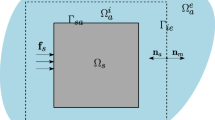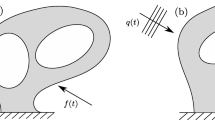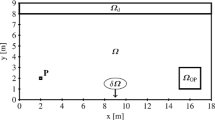Abstract
A new fictitious domain model for topology optimization of time-harmonic problems based on a wave to diffusion equation transition is proposed. By employing negative values of appropriate material coefficients, a tuneable exponential decay of the field amplitude in the fictitious domains can be obtained, whereas for the conventional model a finite field amplitude is always present. To demonstrate the applicability of the model, we consider two topology optimization problems; a volume minimization problem for acoustic topology optimization for which intuitive meaningful designs are obtained with the proposed model unlike the case with a conventional contrast model. For a structural topology optimization example, the proposed model is shown to remove problematic issues with structural artifacts found for a certain dynamic compliance minimization problem.
















Similar content being viewed by others
References
Andreassen E et al (2011) Efficient topology optimization in MATLAB using 88 lines of code. Struct Multidisc Optim 43.1:1–6
Bendsøe MP, Kikuchi N (1988) Generating optimal topologies in structural design using a homogenization method. Comput Methods Appl Mechan Eng 71.2:197–224
Bendsøe MP, Sigmund O (1999) Material interpolations in topology optimization. Archive Appl Mechan 69:635–654
Bendsøe MP, Sigmund O (2003) Topology optimization. Theory methods and applications. Springer, New York
Berggren M, Kasolis F (2012) Weak material approximation of holes with traction-free boundaries. SIAM J Numer Anal 50.4:1827–1848
Bourdin B (2001) Filters in topology optimization. Int J Numer Meth Eng 50.9:2143–2158
Bruns TE, Tortorelli DA (2001) Topology optimization of non-linear elastic structures and compliant mechanisms. Comput Method Appl M 190.26-27:3443–3459
Christiansen RE et al (2015) Creating geometrically robust designs for highly sensitive problems using topology optimization. Struct Multidiscipl Optim 52.4:737–754
Du J., Olhoff N. (2007) Minimization of sound radiation from vibrating bi-material structures using topology optimization. Struct Multidiscipl Optim 33:305–321
Dühring MB, Jensen JS, Sigmund O (2008) Acoustic design by topology optimization. J Sound Vibrat 317.3-5:557–575
Guest JK, Prevost JH, Belytschko T (2004) Achieving minimum length scale in topology optimization using nodal design variables and projection functions. Int J Numer Meth Eng 61.2:238–254. ISSN:00295981
Jensen JS et al (2005) Topology design and fabrication of an efficient double 90(circle) photonic crystal waveguide bend. IEEE Photonic Technol Lett 17.6:1202–1204
Jimenez-Fernandez VM et al (2016) Transforming the canonical piecewise-linear model into a smooth-piecewise representation. In: Springer Plus, vol 5, p 1612
Kasolis F, Wadbro E, Berggren M (2015) Analysis of fictitious domain approximations of hard scatterers. Siam J Numer Anal 53.5:2347–2362
Kim KH, Yoon GH (2015) Optimal rigid and porous material distributions for noise barrier by acoustic topology optimization. J Sound Vibrat 339:123–142
Kumar P, Frouws JS, Langelaar M (2020) Topology optimization of fluidic pressureloaded structures and compliant mechanisms using the Darcy method. Struct Multidisc Optim 61.4:1637–1655
Lee JW, Kim YY (2009) Topology optimization of muffler internal partitions for improving acoustical attenuation performance. Int J Numer Methods Eng 80.4:455–477
Neves MM, Rodrigues H, Guedes JM (1995) Generalized topology design of structures with a buckling load criterion. Struct Multidisc Optim 10.2:71–78
Niu B et al (2018) On objective functions of minimizing the vibration response of continuum structures subjected to external harmonic excitation. Struct Multidiscipl Optim 57.6:2291–2307
Olhoff N, Du J (2016) Generalized incremental frequency method for topological design of continuum structures for minimum dynamic compliance subject to forced vibration at a prescribed low or high value of the excitation frequency. Struct Multidiscipl Optim 54.5, SI:1113–1141
Pedersen NL (2000) Maximization of eigenvalues using topology optimization. Struct Multidiscipl Optim 20:2–11
Rupp CJ et al (2007) Design of phononic materials/structures for surface wave devices using topology optimization. Struct Multidiscipl Optim 34.2:111–121
Goo S et al (2017) Topology optimization of bounded acoustic problems using the hybrid finite elementwave based method. Comput Methods Appl Mechan Eng 313:834–856
Sigmund O (2007) Morphology-based black and white filters for topology optimization. Struct Multidisc Optim 33.4-5:401–424
Sigmund O, Jensen JS (2003) Systematic design of phononic band-gap materials and structures by topology optimization. Phil Trans R Soc Lond A 361.1806:1001–1019
Silva OM, Neves MM, Lenzi A (2020) On the use of active and reactive input power in topology optimization of one-material structures considering steadystate forced vibration problems. In: Journal of sound and vibration, vol 464
Stolpe M, Svanberg K (2001) An alternative interpolation scheme for minimum compliance topology optimization. Struct Multidiscipl Optim 22.2:116–124
Svanberg K (1987) The method of moving asymptotes - a new method for structural optimization. Int J Numer Methods Eng 24:359–373
Wadbro E, Berggren M (2006) Topology optimization of an acoustic horn. Comput Methods Appl Mechan Eng 196.1-3:420–436
Xu S, Cai Y, Cheng G (2010) Volume preserving nonlinear density filter based on heaviside functions. Struct Multidisc Optim 41.4:495–505
Author information
Authors and Affiliations
Corresponding author
Ethics declarations
Conflict of interest
The author declares no conflict of interest.
Additional information
Responsible Editor: YoonYoung Kim
Replication of results
The author has to his best ability included all information necessary for replication of the results both in the text and in dedicated tables. The corresponding Matlab code could be made available on request by emailing the author.
Publisher’s note
Springer Nature remains neutral with regard to jurisdictional claims in published maps and institutional affiliations.
Rights and permissions
About this article
Cite this article
Jensen, J.S. Fictitious domain models for topology optimization of time-harmonic problems. Struct Multidisc Optim 64, 871–887 (2021). https://doi.org/10.1007/s00158-021-02898-z
Received:
Revised:
Accepted:
Published:
Issue Date:
DOI: https://doi.org/10.1007/s00158-021-02898-z




